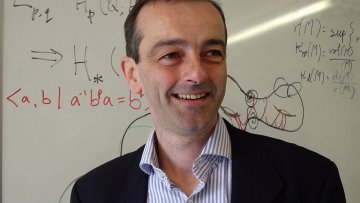Congratulations to Oxford Mathematicians Martin Bridson, Marcus du Sautoy and Artur Ekert who have been elected Fellows of the Royal Society.
16:00
Formal Moduli Problems
Abstract
Let X be a complex algebraic variety containing a point x. One of the central ideas of deformation theory is that the local structure of X near the point x can be encoded by a differential graded Lie algebra. In this talk, Jacob Lurie will explain this idea and discuss some generalizations to more exotic contexts.
Cohomological Donaldson-Thomas Theory and quivers with potential
Abstract
Donaldson-Thomas theory was born as a mean to attach to Calabi-Yau 3-manifolds integers, invariant under small deformation of the complex structure. Subsequent evolutions have replaced integers with cohomological invariants, more flexible and with a broader range of applicable cases.
This talk is meant to be a gentle induction to the topic. We start with an introduction on virtual fundamental classes, and how they relate to deformation and obstruction spaces of a moduli space; then we pass on to the Calabi-Yau 3-dimensional case, stressing how some homological conditions are essential and can lead to generalisation. First we describe the global construction using virtual fundamental classes, then the local approach via the Behrend function and the virtual Euler characteristic.
We introduce quivers with potential, which provide a profitable framework in which to build DT-theory, as they are a source of moduli spaces locally presented as degeneracy loci. Finally, we overview the problem of categorification, introducing the DT-sheaf and showing how it relates to the numerical invariants.
A hyperkähler metric on the cotangent bundle of a complex reductive group
Abstract
Abstract: A hyperkähler manifold is a Riemannian manifold $(M,g)$ with three complex structures $I,J,K$ satisfying the quaternion relations, i.e. $I^2=J^2=K^2=IJK=-1$, and such that $(M,g)$ is Kähler with respect to each of them. I will describe a construction due to Kronheimer which gives such a structure on the cotangent bundle of any complex reductive group.
√T, or not √T, that is the question
Abstract
We consider the motion of a thin liquid drop on a smooth substrate as the drop evaporates into an inert gas. Many experiments suggest that, at times close to the drop’s extinction, the drop radius scales as the square root of the time remaining until extinction. However, other experiments observe slightly different scaling laws. We use the method of matched asymptotic expansions to investigate whether this different behaviour is systematic or an artefact of experiment.




